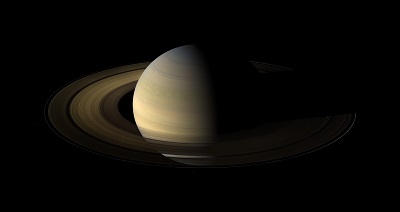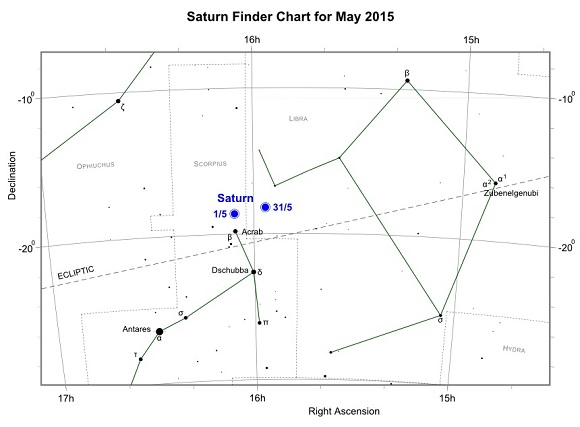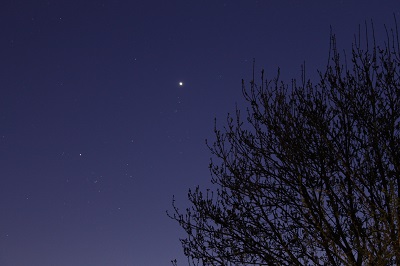Mercury
Mercury remains an early evening object for observers located at tropical and Northern Hemisphere latitudes during the first three weeks of May. The planet is located in Taurus and is visible after sunset towards the west-northwest as soon as it's dark enough.
Mercury climbs higher in the sky each evening until it peaks on May 7th, the date of greatest eastern elongation. For example, from 52N (e.g. London, England) the fast moving planet (mag. +0.2) is positioned 11 degrees above the horizon, 45 minutes after sunset. Afterwards its altitude decreases until it's finally lost to the bright twilight sometime during the third week of the month. It should be noted that Mercury is at its brightest before elongation - it fades from magnitude -0.4 to +1.5 during the first half of May. Located a few degrees northeast of Mercury is much more brilliant Venus (mag. -4.3).
The chart below shows positions of Mercury and Venus from latitude 52N (e.g. London, England). The view will be similar from other northern temperate locations.

On May 12th, Mercury (mag. +1.0) passes 8 degrees north of orange giant star Aldebaran (α Tau - mag. +0.9) the brightest star in Taurus. The fast moving planet then reaches a stationary point on May 19th. Retrograde motion follows pulling Mercury back towards the Sun with it arriving at inferior conjunction on May 30th.
From the Southern Hemisphere the planet is not well placed for observation but may be glimpsed extremely low down above the west-northwestern horizon just after sunset at the start of the month.
Venus
Venus continues as a blazing evening object as it heads towards greatest eastern elongation of 45 degrees on June 6th. The planet is so bright that it can't be mistaken and can be spotted even before the Sun dips below the horizon. During May it brightens from magnitude -4.2 to -4.4 with its apparent size increasing from 17 to 22 arc seconds. The phase of the planet decreases from 67 to 54 degrees during the same period.
The period of visibility of Venus varies considerably depending on location. From northern temperate latitudes the planet sets almost 3.5 hours after the Sun at the start of the month, increasing to 4 hours by months end. However, much further south the planet can be seen for as little as 2 hours. On May 21st the waxing crescent Moon passes 8 degrees south of Venus and at the end of the month, Venus passes 4 degrees south of the Gemini twins, Castor (α Gem - mag. +1.6) and Pollux (β Gem - mag. +1.1).
Mars
Mars has now just a few weeks to go before reaching solar conjunction on June 14th. The "Red planet" spends the first few days of May in Aries before moving into Taurus where it remains for the rest of the month. With an apparent magnitude of only +1.5 it's not bright easily lost to the evening twilight and unlikely to be seen this month.
Jupiter
Jupiter is now 3 months past opposition but despite fading in brightness the planet remains a brilliant object in Cancer. The gas giant is moving direct and positioned 7 degrees southeast of beautiful binocular and small telescope open cluster M44 "The Praesepe".
Jupiter is visible as soon as it's dark enough. At the end of the month, it sets just after midnight from northern temperate latitudes but visibility is somewhat shorter for those living in the tropics and further south. The planets magnitude decreases from -2.1 to -1.9 during May with the apparent size diminishing from 38 to 35 arc seconds over the same time period.
On May 24th, the waxing crescent Moon passes 5 degrees south of Jupiter.

Jupiter during May 2015 - pdf format
Saturn
Saturn reaches opposition on May 23rd and is therefore visible all night as it continues its slow retrograde motion, starting the month in Scorpius before moving into faint Libra on May 12th. The favourite planet of many astronomers is now at it's stunning best with the rings wide open at a tilt of 24.4 degrees and an apparent diameter of 18.5 arc seconds. Including the rings it spans some 42 arc seconds across. The current southerly declination of Saturn means it's much better placed for Southern Hemisphere or tropical based observers.
Through telescopes, Saturn's rings are a wonderful sight and visible even in the smallest of instruments along with Titan, the largest and brightest moon of Saturn. Larger telescopes reveal subtle planet details and many of the planets other moons.
At opposition, Saturn shines at magnitude +0.1 and is positioned 8.967 AU or approximately 1341 million kilometres (833.5 million miles) from Earth. The full Moon passes 2 degrees north of Saturn on May 5th.


Saturn during May 2015 - pdf format
Uranus
Uranus at magnitude +5.9 is currently located in Pisces. For the first half of May from northern temperate latitudes the planet is too down low to be seen against the bright morning twilight. However, the situation quickly improves and by months end Uranus rises over 2 hours before the Sun, therefore visible through binoculars and telescopes against the darker backdrop. Observers located further south have it even better with Uranus well placed in the early morning sky throughout the month. At the start of the May, the planet rises 2 hours before the Sun with the visibility period more than doubling by May 31st.
The waning crescent Moon passes 0.2 degrees north of Uranus on May 15th and an occultation is visible from central South America, west and central Africa (11:55 UT).

Uranus during May 2015 - pdf format
Neptune
Neptune is a morning object amongst the faint stars of Aquarius, the Water Bearer or Water Carrier. The planet is better placed from tropical and southern latitudes, rising in the east some four hours before the Sun at the beginning of the month. By months end it can be seen around midnight. From Northern temperate latitudes Neptune is better seen towards the end of the month when it rises 3 hours or so before the Sun.
At magnitude +7.9, the Solar System's most distant planet is never bright enough to be visible to the naked eye but can be spotted with binoculars and small telescopes. Telescopes at medium to high magnifications reveal a featureless small blue disk that spans just 2.3 arc seconds across.
The last quarter Moon passes 4 degrees north of Neptune on May 12th.

Neptune during May 2015 - pdf format
Solar System Data Table May 2015
| Date | Right Ascension | Declination | Apparent Magnitude | Apparent Size | Illum. (%) | Distance from Earth (AU) | Constellation | |
|---|---|---|---|---|---|---|---|---|
| Sun | 5th May 2015 | 02h 46m 07.3s | 16d 02m 09.8s | -26.7 | 31.7' | 100 | 1.008 | Aries |
| Sun | 15th May 2015 | 03h 25m 05.7s | 18d 41m 08.2s | -26.7 | 31.6' | 100 | 1.011 | Taurus |
| Sun | 25th May 2015 | 04h 05m 01.3s | 20d 48m 40.5s | -26.7 | 31.6' | 100 | 1.013 | Taurus |
| Mercury | 5th May 2015 | 04h 09m 25.5s | 23d 39m 06.4s | 0.0 | 07.5" | 43 | 0.894 | Taurus |
| Mercury | 15th May 2015 | 04h 42m 01.8s | 24d 08m 32.2s | 1.5 | 09.7" | 18 | 0.691 | Taurus |
| Mercury | 25th May 2015 | 04h 40m 48.3s | 21d 44m 44.8s | 4.5 | 11.8" | 03 | 0.571 | Taurus |
| Venus | 5th May 2015 | 05h 44m 30.6s | 25d 52m 54.8s | -4.2 | 17.2" | 66 | 0.969 | Taurus |
| Venus | 15th May 2015 | 06h 33m 18.7s | 25d 56m 03.1s | -4.3 | 18.7" | 61 | 0.892 | Gemini |
| Venus | 25th May 2015 | 07h 20m 01.4s | 24d 56m 22.3s | -4.3 | 20.5" | 57 | 0.813 | Gemini |
| Mars | 5th May 2015 | 03h 29m 17.6s | 19d 11m 14.1s | 1.5 | 03.8" | 100 | 2.479 | Taurus |
| Mars | 15th May 2015 | 03h 58m 37.3s | 20d 51m 38.6s | 1.5 | 03.7" | 100 | 2.507 | Taurus |
| Mars | 25th May 2015 | 04h 28m 12.6s | 22d 12m 15.6s | 1.5 | 03.7" | 100 | 2.531 | Taurus |
| Jupiter | 5th May 2015 | 09h 04m 40.3s | 17d 40m 09.1s | -2.1 | 37.4" | 99 | 5.272 | Cancer |
| Jupiter | 15th May 2015 | 09h 08m 17.7s | 17d 23m 38.1s | -2.0 | 36.3" | 99 | 5.431 | Cancer |
| Jupiter | 25th May 2015 | 09h 12m 52.2s | 17d 02m 41.0s | -2.0 | 35.3" | 99 | 5.586 | Cancer |
| Saturn | 5th May 2015 | 16h 04m 28.3s | -18d 33m 22.0s | 0.2 | 18.4" | 100 | 9.016 | Scorpius |
| Saturn | 15th May 2015 | 16h 01m 31.8s | -18d 25m 00.5s | 0.1 | 18.5" | 100 | 8.977 | Libra |
| Saturn | 25th May 2015 | 15h 58m 27.4s | -18d 16m 30.9s | 0.1 | 18.5" | 100 | 8.967 | Libra |
| Uranus | 5th May 2015 | 01h 06m 42.6s | 06d 25m 08.6s | 5.9 | 03.4" | 100 | 20.896 | Pisces |
| Uranus | 15th May 2015 | 01h 08m 36.4s | 06d 36m 39.4s | 5.9 | 03.4" | 100 | 20.812 | Pisces |
| Uranus | 25th May 2015 | 01h 10m 21.0s | 06d 47m 09.5s | 5.9 | 03.4" | 100 | 20.705 | Pisces |
| Neptune | 5th May 2015 | 22h 44m 19.7s | -08d 49m 04.9s | 7.9 | 02.2" | 100 | 30.381 | Aquarius |
| Neptune | 15th May 2015 | 22h 44m 59.9s | -08d 45m 24.9s | 7.9 | 02.3" | 100 | 30.224 | Aquarius |
| Neptune | 25th May 2015 | 22h 45m 28.5s | -08d 42m 55.0s | 7.9 | 02.3" | 100 | 30.058 | Aquarius |
